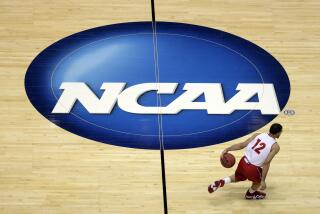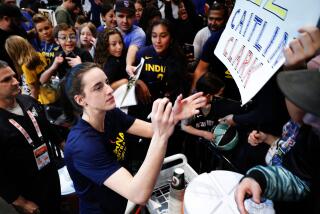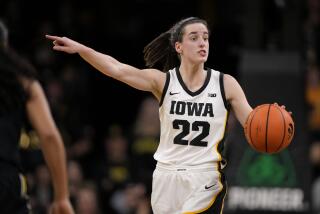Showcasing Shooters and Shoes : Basketball: Summer camps and tournaments offer players a chance to make a name for themselves. But critics say the athletes are being exploited.
Tremaine Fowlkes of Crenshaw High was a relatively unknown college basketball prospect by national standards until he showcased his talents in summer tournaments in Michigan, California and Nevada.
The 6-foot-6 Fowlkes, who earned fame while competing in the Converse ABCD Summer Jam 1993 July 3-9 on the campus of Eastern Michigan University in Ypsilanti, is now considered one of the top five senior prospects in the state and one of the top 10 small forwards in the country.
“You look at the preseason scouting reports and Tremaine Fowlkes was nowhere to be found,” ABCD organizer Sonny Vaccaro said. “He is a classic example of a player who made a name for himself while competing in national summer tournaments.”
Often promoted by athletic shoe companies, the summer tournaments, which usually start the last week of June and run through July, provide an important showcase for players and give college coaches a chance to scout top seniors who are likely to agree to letters of intent during the Nov. 10-17 early signing period.
Critics, however, say that young athletes are exploited by shoe companies and other firms that sponsor the tournaments. Organizers offer perks such as free shoes, sporting equipment and athletic wear to lure top players to their summer tournaments. In exchange, athletes are often asked questions about the products and their responses are used to formulate marketing strategies for the shoe companies. The athletes also become walking advertisements for the athletic wear.
In addition, tournament organizers often waive entry fees for top players and use their names to promote tournaments and attract lesser-known players who pay hundreds of dollars to compete. Such perks to top players have drawn complaints from NCAA officials and coaches who believe they threaten the amateur standing of athletes before they reach college.
“I think summer camps can be worthwhile if people (are) not allowed to manipulate kids for personal reasons,” said USC Coach George Raveling, an outspoken opponent of summer camps. “I don’t have a problem when a player receives a scholarship because he cannot afford to attend the camp with his own means. I object to the ‘gifts’ that young people receive that ultimately cause a sense of obligation. I think all summer camps have gone too long being unregulated.”
Vaccaro rebutted critics who say that only superstars receive financial help with fees and transportation. In fact, he said that the ABCD tournament does the opposite--that is, provides aid to players who would not ordinarily get a chance to participate.
“The purpose of the ABCD tournament is to treat everyone equally, to give the youths who can’t pay for transportation and can’t pay for equipment an opportunity to compete with the best players in the nation. Why penalize the masses to protect the few (superstars)?”
Raveling’s cross-town rival, UCLA Coach Jim Harrick, and other coaches acknowledge that incentives are common in summer tournaments, but add that the competitions are the most effective way for scouts and coaches to see hundreds of players in a short time.
“The positives are we buy one airplane ticket and you get to see 100 to 125 of the top players competing against each other in one tournament,” Harrick said. “For that one situation, there is no finer way for us to see so many players at one time.”
Harrick, who said he scouted more than 250 of the nation’s best players in the ABCD and the Nike All-American Basketball Festival tournaments, has already received an unwritten commitment from 6-6 forward Toby Bailey of Loyola High and is projected to have one of the top recruiting classes in the country in 1994.
Bob Gibbons of Lenoir, N.C.-based All Star Sports, a respected basketball scouting service and recruiting newsletter, selects the 130 players who compete at the Nike tournament. He said the camps are important because each year 80 of his top 100 prospects sign in November. Considering that the high school basketball season does not start until the first week of December, and fewer scholarships are offered, college coaches cannot afford to make a mistake.
“I think summer camps and tournaments provide a forum for meaningful evaluation of players,” Gibbons said. “During the high school season, coaches and scouts have to crisscross the nation to see talented individuals compete against overmatched or undersized opponents. It’s hard to draw conclusions. Summer tournaments truly are the best situation because you see the best players compete against the best.”
Bailey, who competed in the Nike tournament in July at the Hoosier Dome in Indianapolis, returned home with a new pair of shoes, six T-shirts, three pairs of shorts, hats and a practice jersey. He said he did not feel exploited by the experience.
“I thought it was a lot of fun,” he said. “I got to show how I ranked against the best players. I would be disappointed if my brother and his friends did not get a chance to participate in a national tournament.”
Said Bailey’s father, John: “Toby has been playing since he was 5. Nike was the culmination of a lot of hard work in the gym and a lot of practice. The people with Nike were very straight up and good people. Toby had a wonderful time. I don’t think he was used or abused.”
Still, some critics charge that players are being used without really being aware of it. Fearing that, the NCAA enacted legislation at its national convention in January to regulate summer camps, but not summer tournaments. It ruled that college coaches could only attend camps certified by the NCAA. In order to gain certification, a camp must charge an admission fee to all participants. The NCAA amendment does not allow financial aid provisions for needy students.
The ABCD and Nike tournaments do not charge entry fees, and pay for all travel and boarding expenses for participants. The West Coast All-Star Camp, run by twin brothers David and Dana Pump, charged each camper $440 for five days of training and competition, July 9-12, at Cal State Dominguez Hills. Dana Pump said 30 campers were given scholarships because they showed financial need.
The NCAA also banned inducements such as free transportation and athletic equipment other than T-shirts for campers. In addition, players are limited to competing in camps no more than 100 miles away from their residence.
ABCD and Nike circumvented the rules by changing their events from full-service camps to tournaments. In the past, ABCD and Nike offered campers educational services such as tips on how to take college entrance examinations, guest lectures and counseling seminars. When the NCAA instituted its new amendment, ABCD and Nike dropped the educational services and added more athletic competition, such as shooting and dunking contests.
Another amendment has been proposed that will, in essence, eliminate any loopholes and force the regulation of camps. More than 60 camps are already certified by the NCAA, including the West Coast All-Star Camp, Raveling said.
Steve Mallonee, NCAA director of legislative services, said the rules were changed because “coaches were concerned that conduct of these camps were exploiting youths and that their operations were inconsistent with the principals that govern college athletics.”
“They offer all these inducements and provide benefits to come to their camps. When (athletes) go to college, they cannot get these extra benefits,” Mallonee said. “The other concern was that camp operators were exerting a lot of influence on participants and directing youths to certain schools. They were interjecting themselves into the recruiting process.”
Vaccaro responded: “I wish the NCAA would name names and stop speaking in generalities. They insinuate that there are outside influences, but they won’t say who is causing the problems. Instead, they incriminate everyone involved with the game.”
Richard Sheubrooks, who manages basketball events for Nike, said his company will return next year and run a national camp that will adhere to the new policies.
“The camp gives us an opportunity to observe the best players and listen to what they tell us about our products,” Sheubrooks said.
Sheubrooks said Nike sees no conflict in asking players to comment on Nike products while participating in the company’s camps and tournaments.
“These guys are the guys who are buying the products and they have great ideas to share,” Sheubrooks said. “Many of the high school players who talk at specific focus groups (away from the camps) are very creative and we see another side of them other than their basketball talents.”
Vaccaro, who started and ran the Nike camp from 1982 to 1991, said he believes the new rules are unfair to inner-city youths who cannot afford to attend camps.
“I think it’s discriminatory against people who want to improve themselves,” Vaccaro said. “The people who put the rules together are only looking at the superstars who are involved in the process and forgetting about the hundreds of kids who play with the superstars. Everyone knows that Rick Price and Jelani Gardner are great players. . . . They’re going to get scholarships no matter what. But what about the others who are not the top 20 mythical kids? How are they going to get exposure if they cannot afford to attend these camps?
“(And) these same coaches, who make these decisions, take student athletes and get rid of them in a year, or they don’t make sure their players graduate. Who says they are without sin?”
Despite the fears of some coaches and NCAA administrators, the consensus by players was that summer events are worthwhile.
“I didn’t feel I was getting manipulated,” said Crenshaw forward Kris Johnson, who attended the ABCD camp. “I don’t think it was a meat market. I attended summer camps because I’m trying to better my chances to go to college. ABCD was a steppingstone for me to go to the school where I want to go. I got the opportunity to meet and play the best players in the nation.”
Manual Arts junior guard Darwin Carter competed in the Pump Discovery Classic in July at Cal State Dominguez Hills and hopes to compete next season at either Nike or ABCD. “I think the camps make me play harder,” Carter said. “They play better defense so you have to learn how to score against better players.”
Major Basketball Tournaments
Often promoted by athletic shoe companies, the summer tournaments provide a important showcase for players. Critics, however, say that young athletes are exploited. Organizers offer perks such as free shoes, sporting equipment and athletic wear to lure top players to participate. In exchange, athletes are often asked questions about the products and their responses are used to formulate marketing strategies.
Tournament: Converse/ABCD Summer Jam 1993 Dates: July 3-9 Location: Eastern Michigan University, Ypsilanti, Mich. * Tournament: Nike All-American Basketball Festival Dates: July 5-11 Location: Hoosier Dome, Indianapolis, Ind. * Tournament: Pat Yount Superstar Camp Dates: July 11-15 Location: UC San Diego, La Jolla, Ca. * Tournament: Nike Five-Star Camp Pittsburgh II week (Howard Garfinkel camp) Dates: July 13-18 Location: Robert Morris College, Pittsburgh, Pa. * Tournament: AAU National Tournament (for boys 17 and under) Dates: July 17-24 Location: Lawrence Joel Coliseum, Winston-Salem, N.C. * Tournament: L.A. Gear Slam-n-Jam National Invitational Tournament Dates: July 17-22 Location: Cal State Long Beach, Long Beach, Ca. * Tournament: Nike Las Vegas National Invitational Tournament Dates: July 17-24 Location: University of Nevada-Las Vegas * Tournament: Basketball Congress International Summer Prep Tournament Dates: July 25-31 Location: Arizona State University, Tempe Ariz.
More to Read
Go beyond the scoreboard
Get the latest on L.A.'s teams in the daily Sports Report newsletter.
You may occasionally receive promotional content from the Los Angeles Times.










